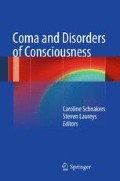Abstract
Taking care of patients recovering from coma is not easy, as current therapeutics are neither well developed nor well validated. Sensory stimulation programs are the most widely known treatment applied to severely brain-injured patients. In this chapter, we will introduce the theoretical principles underlying these programs and the studies assessing their clinical interest. We will also discuss the limitations of this treatment and consider future directions for clinical research.
Access this chapter
Tax calculation will be finalised at checkout
Purchases are for personal use only
References
Wood R. Critical analysis of the concept of sensory stimulation for patients in vegetative states. Brain Inj. 1991;5(4):401–9.
Hummel F, Cohen L. Drivers of brain plasticity. Curr Opin Neurol. 2005;18(6):667–74.
Voss H, Uluc A, Dyke J, et al. Possible axonal regrowth in late recovery from the minimally conscious state. J Clin Invest. 2006;116(7):2005–11.
Jones R, Hux K, Morton-Anderson K, Knepper L. Auditory stimulation effect on a comatose survivor of traumatic brain injury. Arch Phys Med Rehabil. 1994;75(2):164–71.
Ansell B, Keenan J. The Western Neuro Sensory Stimulation Profile: a tool for assessing slow-to-recover head-injured patients. Arch Phys Med Rehabil. 1989;70:104–8.
Merabet L, Pascual-Leone A. Neural reorganization following sensory loss: the opportunity of change. Nat Rev Neurosci. 2010;11(1):44–52.
Barnes S, Finnerty G. Sensory experience and cortical rewiring. Neuroscientist. 2010;16(2):186–98.
Diamond M. Enriching heredity. New York: The Free Press; 1988.
Renner M, Rosenzweig M. Enriched and improverished environments: effects on brain and behaviour. New York: Springer; 1987.
Nithianantharajah J, Hannan J. Enriched environments, experience-dependent plasticity and disorders of the nervous system. Nat Rev Neurosci. 2006;7(9):697–709.
Sale A, Berardi N, Maffei L. Enrich the environment to empower the brain. Trends Neurosci. 2009;32(4):233–9.
LeWinn E, Dimancescu M. Environmental deprivation and enrichment in coma. Lancet. 1978;2:156–7.
Blackerly WF. Intensity of rehabilitation and length of stay. Brain Inj. 1990;4(2):167–73.
Doman G, Wilkinson R, Dimancescu M, Pelligra R. The effects of intense multi-sensory stimulation on coma arousal and recovery. Neuropsych Rehabil. 1993;3(2):203–12.
Hall M, MacDonald S, Young G. The effectiveness of directed multisensory stimulation versus non directed stimulation in comatose closed head injured patients: pilot study of a single subject design. Brain Inj. 1992;6(5):435–45.
Lippert-Grüner M, Terhaag D. Multimodal early onset stimulation (MEOS) in rehabilitation after brain injury. Brain Inj. 2000;14(6):585–94.
Mitchell S, Bradley V, Welch J, Britton P. Coma arousal procedure: a therapeutic intervention in the treatment of head injury. Brain Inj. 1990;4(3):273–9.
Sisson R. Effects of auditory stimuli on comatose patients with head injury. Heart Lung. 1990;19(4):373–8.
Tablot L, Whitaker H. Brain-injured persons in an altered state of consciousness: measures and intervention strategies. Brain Inj. 1994;8(8):689–99.
Wilson S, Powell G, Elliott K, Thwaites H. Sensory stimulation in prolonged coma: four single case studies. Brain Inj. 1991;5(4):393–400.
Wilson S, Powell G, Brock D, Thwaites H. Behavioural differences between patients who emerged from vegetative state and those who did not. Brain Inj. 1996;10(7):509–16.
Lombardi F. Sensory stimulation of brain-injured individuals in coma or vegetative state: results of a Cochrane systematic review. Clin Rehabil. 2002;16:465–73.
Kater K. Response of head-injured patients to sensory stimulation. West J Nurs Res. 1989;11:20–33.
Teasdale G, Jennett B. Assessment of coma and impaired consciousness. A practical scale. Lancet. 1974;2(7872):81–4.
Johnson D, Roethig Johnston K, Richards D. Biochemical and physiological parameters of recovery in acute severe head injury: responses to multisensory stimulation. Brain Inj. 1993;7(6):491–9.
Davis A, Gimenez A. Cognitive-behavioral recovery in comatose patients following auditory sensory stimulation. J Neurosci Nurs. 2003;35(4):202–9.
Urbenjaphol P, Jitpanya C, Khaoropthu S. Effects of the sensory stimulation program on recovery in unconscious patients with traumatic brain injury. J Neurosci Nurs. 2009;41:10–6.
Oh H, Seo W. Sensory stimulation programme to improve recovery in comatose patients. J Clin Nurs. 2003;12:394–404.
Giacino J, Kalmar K, Whyte J. The JFK Coma Recovery Scale-Revised: measurement characteristics and diagnostic utility. Arch Phys Med Rehabil. 2004;85(12):2020–9.
Schnakers C, Majerus S, Giacino J, et al. A French validation study of the Coma Recovery Scale-Revised (CRS-R). Brain Inj. 2008;22(10):786–92.
Schnakers C, Giacino J, Kalmar K, et al. Does the FOUR score correctly diagnose the vegetative and minimally conscious states? Ann Neurol. 2006;60(6):744–5.
Groswasser Z, Cohen M, Blankstein E. Polytrauma associated with traumatic brain injury: incidence, nature and impact on rehabilitation outcome. Brain Inj. 1990;4:161–6.
Author information
Authors and Affiliations
Corresponding author
Editor information
Editors and Affiliations
Rights and permissions
Copyright information
© 2012 Springer-Verlag London
About this chapter
Cite this chapter
Di, H., Schnakers, C. (2012). Sensory Stimulation Program. In: Schnakers, C., Laureys, S. (eds) Coma and Disorders of Consciousness. Springer, London. https://doi.org/10.1007/978-1-4471-2440-5_10
Download citation
DOI: https://doi.org/10.1007/978-1-4471-2440-5_10
Published:
Publisher Name: Springer, London
Print ISBN: 978-1-4471-2439-9
Online ISBN: 978-1-4471-2440-5
eBook Packages: MedicineMedicine (R0)

